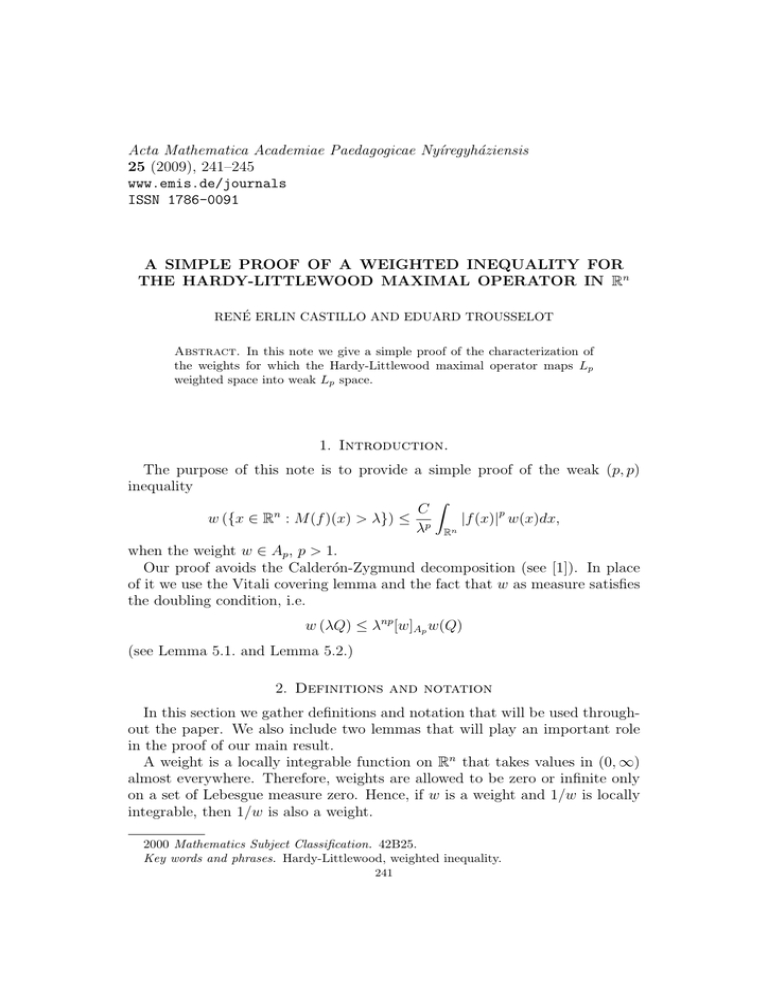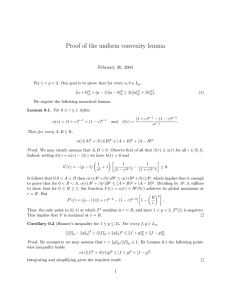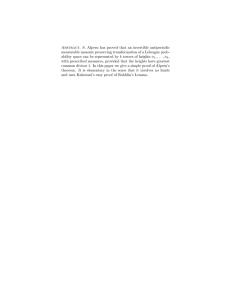Acta Mathematica Academiae Paedagogicae Ny´ıregyh´aziensis 25 (2009), 241–245 www.emis.de/journals ISSN 1786-0091
advertisement

Acta Mathematica Academiae Paedagogicae Nyı́regyháziensis
25 (2009), 241–245
www.emis.de/journals
ISSN 1786-0091
A SIMPLE PROOF OF A WEIGHTED INEQUALITY FOR
THE HARDY-LITTLEWOOD MAXIMAL OPERATOR IN Rn
RENÉ ERLIN CASTILLO AND EDUARD TROUSSELOT
Abstract. In this note we give a simple proof of the characterization of
the weights for which the Hardy-Littlewood maximal operator maps Lp
weighted space into weak Lp space.
1. Introduction.
The purpose of this note is to provide a simple proof of the weak (p, p)
inequality
Z
C
n
w ({x ∈ R : M (f )(x) > λ}) ≤ p
|f (x)|p w(x)dx,
λ Rn
when the weight w ∈ Ap , p > 1.
Our proof avoids the Calderón-Zygmund decomposition (see [1]). In place
of it we use the Vitali covering lemma and the fact that w as measure satisfies
the doubling condition, i.e.
w (λQ) ≤ λnp [w]Ap w(Q)
(see Lemma 5.1. and Lemma 5.2.)
2. Definitions and notation
In this section we gather definitions and notation that will be used throughout the paper. We also include two lemmas that will play an important role
in the proof of our main result.
A weight is a locally integrable function on Rn that takes values in (0, ∞)
almost everywhere. Therefore, weights are allowed to be zero or infinite only
on a set of Lebesgue measure zero. Hence, if w is a weight and 1/w is locally
integrable, then 1/w is also a weight.
2000 Mathematics Subject Classification. 42B25.
Key words and phrases. Hardy-Littlewood, weighted inequality.
241
242
RENÉ ERLIN CASTILLO AND EDUARD TROUSSELOT
Given a weight w and a measurable set E, we will use the notation
Z
w(E) =
w(x)dx,
E
to denote the w-measure of the set E. Since weights are locally integrable
functions w(E) < ∞ if E is a bounded set.
The weighted Lp space will be denote by Lp (w).
3. The Hardy-Littlewood maximal operator
The uncentered Hardy-Littlewood maximal operator of a locally integrable
function f on Rn is defined by
Z
1
M (f )(x) = sup
|f (y)| dy,
x∈B m(B) B
where the supremum is taken over all open balls B(y, r) (r > 0) that contain
the point x, and m(·) denotes n−dimensional Lebesgue measure. Lebesgue
measure on Rn will also be denoted by dx.
Also recall the definition of the weighted uncentered Hardy-Littlewood maximal operator on Rn over balls
Z
1
|f (y)| dy,
Mw (f )(x) = sup
x∈B w(B) B
where w is any weight.
4. The Ap condition
Definition 4.1. Let 1 < p < ∞. A weight w is said to be of class Ap if
µ
¶µ
¶
Z
Z
1
1
1
− p−1
(4.1)
sup
w(x)dx
w(x)
dx < ∞.
m(B) B
m(B) B
B balls in Rn
The expression in (4.1) is called the Ap Muckehoupt characteristic constant
of w and will be denoted by [w]Ap .
Remark 1. The Ap condition first appeared, in somewhat different form, in a
paper by M. Rosenblum (see [3]). The characterization of Ap when n = 1 is
due to B. Muckenhoupt (see [2]).
5. Properties of Ap weights
We summarize some basic properties of Ap in the following lemma.
Lemma 5.1. Let w ∈ Ap for some 1 ≤ p < ∞. Then
(1) [τ z (w)]Ap = [w]Ap , where τ z (w)(x) = w(x − z), z ∈ Rn .
(2) [λw]Ap = [w]Ap for all λ > 0.
(3) For 1 ≤ p < q < ∞, we have [w]Aq ≤ [w]Ap .
(4) limp→1+ [w]Ap = [w]A1 if w ∈ A1 .
A SIMPLE PROOF OF A WEIGHTED INEQUALITY. . .
243
(5) The following is an equivalent characterization of the Ap characteristic
constant of w
´p
³
R
1
m(B)
|f
(x)|
dx
B
R
sup
[w]Ap = sup
.
p
1
B f ∈Lp (w):m(B∩{|f |=0})=0 w(B) B |f (x)| w(x)dx
(6) The measure w(x)dx is doubling: precisely, for all λ > 1 and all cubes
B we have
w(λB) ≤ λnp [w]Ap w(B),
where λB(x, r) = {y ∈ Rn : |x − y| < λr}, (λ > 0).
The following lemma is due to Vitali, and it will play an important role in
the proof of our main result.
Lemma 5.2. Let E be an open set in Rn and let {Qj } be a family of cubes
covering E. Then there exists a countable subfamily {Qjk } of disjoints cubes
such that
[
5Qjk .
E⊂
k
6. Main Result
We like to point out that the proof of the main result in this paper (theorem
6.1) is direct and fairly elementary. Instead of the one that use the heavy tool
provide by Calderón-Zygmund decomposition. Indeed, we use only Hölder’s
inequality and Vitali’s covering Lemma (see lemma 5.2 in this paper) and the
fact that w as measure satisfies the doubling condition (see the introduction
in the present paper)
Theorem 6.1. For 1 ≤ p < ∞, then weak (p, p) inequality
Z
C
n
w ({x ∈ R : M f (x) > λ}) ≤ p
|f (x)|p w(x)dx
λ Rn
holds if and only if w ∈ Ap .
Proof. Using Hölder’s inequality we see that
µ
1
m(Q)
¶p µ
|f |dx =
Z
Q
·
(6.1)
¸p µZ
1
m(Q)
Z
1
|f (x)|w p w
Q
− p1
¶p
dx
¶ µZ
¶p
q
1
− pq
p
|f (x)| w(x)dx
w (x)dx
≤
m(Q)
Q
Q
µ
¶
µ
¶p−1
Z
Z
1
w(Q)
1
− 1
≤
|f (x)|p w(x)dx
w p−1 (x)dx
w(Q) Q
m(Q) m(Q) Q
¶
µ
Z
1
|f (x)|p w(x)dx [w]Ap ,
≤
w(Q) Q
244
RENÉ ERLIN CASTILLO AND EDUARD TROUSSELOT
since
1
Mw (f )(x) = sup
x∈Q w(Q)
Z
|f (x)|w(x)dx.
Q
Fix λ > 0, from (6.1) we get
½
¾
λp
n
p
{x ∈ R : M (f )(x) > λ} ⊂ x ∈ R : Mw (f )(x) >
.
C
n
Thus,
µ½
n
w ({x ∈ R : M (f )(x) > λ}) ≤ w
©
let Aλ = x ∈ Rn : Mw (f p )(x) >
such that
(6.2)
λp
C
ª
1
λp
<
C
w (Qx )
λp
x ∈ R : Mw (f )(x) >
C
n
p
¾¶
,
for each x ∈ Aλ there exists a cube Qx
Z
|f |p w(x)dx
Qx
from (6.2) it is easy to see that Aλ ⊂ ∪x∈Aλ Qx , since Mw (f p )(x) is lower
semicontinuous,
©
ªthen Aλ is an open set. Thus, by Lemma 5.2 one can have a
subfamily Qxj of disjoints cubes such that
[
Aλ ⊂
5Qxj ,
j
then
w(Aλ ) ≤ w
≤
Ã
[
X
!
5Qxj
j
¡
¢
w 5Qxj
j
≤ 5pn [w]Ap
X
¡
¢
w Qxj
j
¤
Thus, theorem 5.3 follows from (5.2)
References
[1] A. P. Calderon and A. Zygmund. On the existence of certain singular integrals. Acta
Math., 88:85–139, 1952.
[2] B. Muckenhoupt. Weighted norm inequalities for the Hardy maximal function. Trans.
Amer. Math. Soc., 165:207–226, 1972.
[3] M. Rosenblum. Summability of Fourier series in Lp (dµ). Trans. Amer. Math. Soc.,
105:32–42, 1962.
A SIMPLE PROOF OF A WEIGHTED INEQUALITY. . .
Received on August 28, 2008; accepted on March 8, 2009
René Erlin Castillo,
Departamento de Matemática,
Universidad de Oriente,
6101 Cumaná, Edo. Sucre,
Venezuela
E-mail address: rcastill@math.ohiou.edu
Eduard Trousselot,
Departamento de Matemáticas,
Universidad de Oriente,
6101 Cumaná, Edo. Sucre,
Venezuela
E-mail address: eddycharles2007@hotmail.com
245







